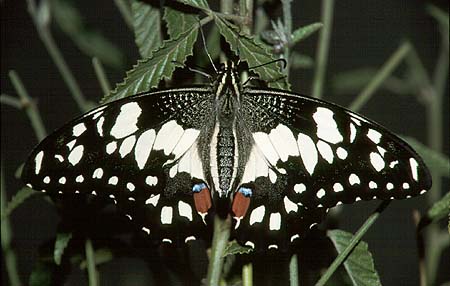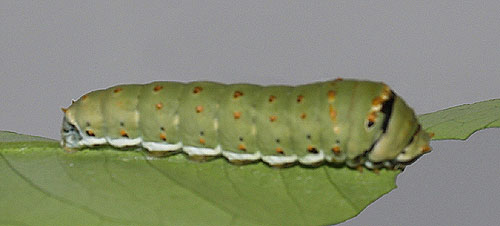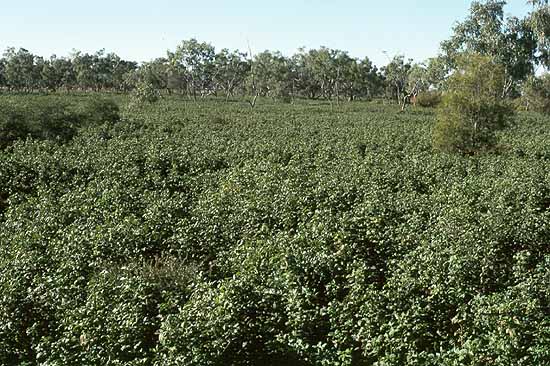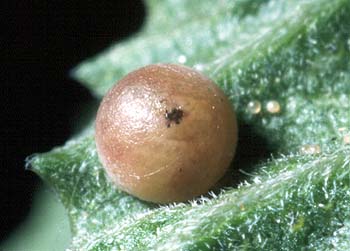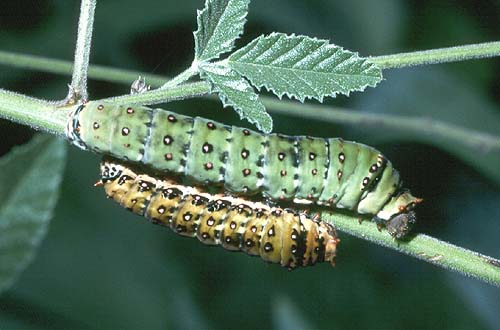-
Larval Food Host
-
Normally Cullen (Psoralea) spp including
C. australasicum (tall scurf-pea),
C. cinereum (annual scurf-pea),
C. graveolens (native lucerne),
C. patens (spreading scurf-pea),
*Psoralea pinnata (African scurf-pea) (Fabaceae).
Overseas, the larvae feed on *Citrus spp and other Rutaceae plants,
and sometimes *Ziziphus jujuba (Rhamnaceae)
but will rarely utilise these hostplants in Australia.
Larvae eat the softer green parts of the hostplants.
-
Eggs
-
Large, pale yellow, nearly spherical about 1.5 mm, basally flattened, smooth.
If fertile a small red mark or cross develops at the apex of the egg.
Laid singly near the edges of the hostplant leaves.
Those females utilising Citrus will lay eggs on both new and old
growth. Larval development within the egg commences immediately after being
laid. The egg shell is eaten by the larva after its emergence.
-
Larvae
-
Initially, black coloured, with two subdorsal rows of short, bristly, fleshy spines.
The head is also black. Second, third and fourth instars are dark brown, shiny,
with the anterior, middle and posterior parts with broad transverse off-white bands,
giving the larva a 'bird dropping' camouflage pattern typical for the swallowtail
group of butterflies. The fleshy spines are less prominent and not as bristly.
They also aquire an additional row of paired fleshy spines on the thorax. Head brown,
smooth, shining, with some short hairs. The immature larva eats the egg shell after
emergence, before proceeding to scour the leaf surface. Later instars devour the
entire leaf, from any part of the plant.
Mature larvae from southern areas are about 45 mm long, cylindrical shaped, tapered
anteriorly, with a very short pair of fleshy spines located posteriorly and again
immediately behind the head. Green coloured with a lateral row and two pairs of
subdorsal rows of orange or pink spots edged black. There are some additional black
transverse markings anteriorly, with further scattered black markings both laterally
and at the rear end, and there is a white sublateral line along the abdominal area
just above the legs. The fleshy spines are orange coloured. The head is large, brown
coloured with a dull orange inverted V mark. The final instar after moulting from
the fourth instar is yellowish-orange coloured and closely resembles the dying discoloured
older leaves of the hostplant. The orange colour gradually changes to green, which
is a normal leaf camouflage colour. Larvae from the hot north of the state tend to
have few black markings, and the pink spots may also be absent, and these larvae then bear
some resemblance to the mature larvae found in overseas tropical areas.
All larvae remain exposed on the hostplant. When disturbed, the larvae can evert
a reddish orange coloured, fleshy bifid osmeterium
from behind the head that emits a distinct pungent odoriferous secretion, which acts
as a deterrent to both vertebrate (birds, lizards and mice) and invertebrate (ants, spiders
and wasps) predators. It is more effective if the chemical can be deposited on the predator,
hence the larvae will attempt to throw their heads (and osmeterium) either backwards or
sideways if a predator attacks from the rear. The secretion is usually composed of a
butyric acid compound having irritant properties. This osmeterium is present in all
stages of the larvae, and is found in all the Papilionidae group of butterflies. In
other species the osmeterium can have a different colour such as green, blue or black.
The early stage biology of this butterfly is very unusual. Outside of the Australian Region
its larvae prefer to feed on Citrus where the
mature larvae
are green with a pair of subdorsal eye spots on the thorax, and often with white or
brown diagonally striped patches on their sides. In Australia the female butterfly
does not normally lay eggs on Citrus (either introduced or endemic species),
although very recently it has been reported to utilise domestic garden Citrus
(orange and lemon) growing at Alice Springs in Central Australia. However, females
can be induced to lay eggs on Citrus in captivity and the resultant young larvae
will eat the Citrus through to maturity. Similarly, larvae collected from
Cullen in the wild can sometimes be transferred successfully onto Citrus
in captivity. Such larvae may eventually pupate, but the resultant butterflies are
usually smaller than those that utilise Cullen as a hostplant. White patched larvae
feeding on Cullen have been seen in the Far North of the state, but when young
larvae from this population were taken south to the cooler areas of Adelaide and reared
to maturity on Cullen, the resultant larvae were either the orange dotted form
described above or had markings in between the two (i.e. with either no orange spots
or a reduced number of spots, and no white patch).
Interestingly, the sister species Papilio demodocus also has two forms of
larvae in which one form results from feeding on Citrus (Rutaceae) that is green
coloured with a white or brown diagonal stripe half way along the body, similar to
Papilio aegeus. (This form is similar to the
larvae of P. demoleus found in the tropical Orient). The other form, that is similar
to larvae of P. demoleus found in Australia, occurs when larvae feed on other types
of hostplants like fennel (Umbelliferae).
-
Pupae
-
Reasonably stout, rugose, about 30 mm long, the ventral part containing the wing cases
and the dorsal abdominal part are bowed, anterior end produced into a short pair of
flattened projections, the thorax has prominent projections dorsally and laterally,
and there is an additional projection laterally where the abdomen meets the wing case.
There are also ridges laterally along the thorax and again between the dorsal and
lateral-abdominal projections. It is sometimes attached to the thicker stems of the
hostplant, but prefers to leave the hostplant to pupate on adjacent plants, sticks
and rocks. It reclines from the vertical, and is attached by the posterior cremaster
and a central silken girdle. The colour is dimorphic, typical for many swallowtails,
being either pale green or pink-brown with other variable cryptic markings. The green
form is usually marked dorsally with yellow. The colour pattern imitates the dominant
surrounding colour to which the pupa is attached. If the surrounding parts are leafy
and green, then the pupal colour is green, or if the surrounds are mostly of dead leaves
or are rocky then the pupa is brown.The pupal duration is variable. In southern settled
areas it is about 30 days in spring, reducing to 18 days in summer, but often those pupae
formed in captivity during autumn will not produce adults until the following spring,
or even longer with one diapause record of 280 days.
-
Flight Period in South Australia
-
A somewhat nomadic butterfly. In northern pastoral areas it is possible to find the
butterfly throughout the year, but is most common after rainy periods when its perennial
hostplant flushes into a lush growing condition. In the southern settled areas it is
usually seen during the warmer months, particularly in spring and early summer when it
tends to fly south from the northern areas. It will breed continuously during the warmer
months of the year, providing its hostplant remains in a growing condition. In the south
a brood can be completed in 7-10 weeks.

-
Distribution
-
Occurs throughout mainland Australia, but yet to be recorded from Kangaroo Island.
It is most common in the tropical and subtropical north of Australia. In South
Australia it readily breeds in northern pastoral areas after rain. Rarely seen
in southern settled areas, where it may occur at great distances from its Cullen
hostplants. It sometimes takes up residence in southern settled areas if its
hostplants are present, but these colonies are usually not permanent as the hostplant
often dies back to its perennial base during summer, and the growing area of hostplant
is often too small to sustain viable populations of the butterfly, and under these
circumstances the early stages of the butterfly are prone to disease and parasitoids.
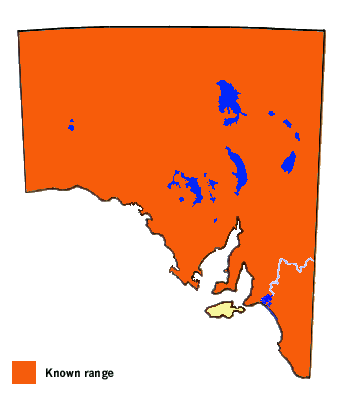
-
Habitat
-
The Cullenhostplant grows in open woodland and grassland, particularly in
floodplain areas. In the Far North pastoral areas the hostplant is common after
rains, both roadside and along the ephemeral creek systems.
-
Conservation Status in South Australia
-
A vagrant, locally common in northern pastoral areas, rare in the southern settled areas.
-
Threats
-
Only threatened in the southern settled areas where its Cullen hostplants
have been largely grazed out of existence. In the northern pastoral areas the same
hostplant is the preferred plant for grazing by cattle after rains, and it is
therefore surprising the butterfly is as common as it is.
-
Conservation Strategy
-
None required. It is likely to occur in large numbers on aboriginal lands in the
Far North, where cattle grazing no longer occurs. Its attractive hostplant should
be considered for revegetation projects in the southern settled areas.
